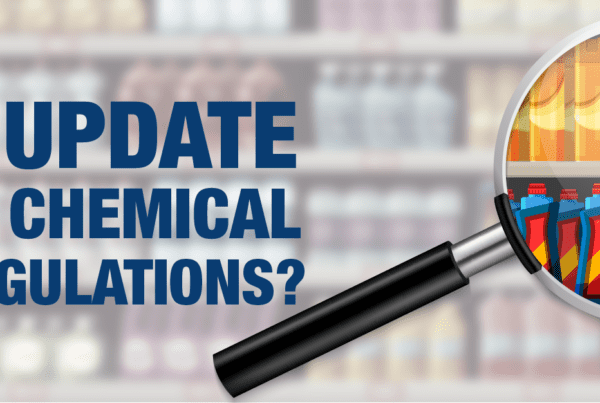
WHMIS2015 (“Workplace Hazardous Materials Information System, 2015”) has been in place since, well, 2015. Over the past half-decade, the Canadian industry has worked to adjust to the new way of handling hazard communication for workplace chemicals. The standard now is based on the Globally Harmonized System of Classification and Labelling, 5th Revision, known more simply as the GHS or sometimes, based on its cover, as the Purple Book. But since WHMIS2015 came into effect, the GHS has moved onward. Now, Health Canada, the department in charge of implementing WHMIS, will play a bit of “catch up” in an amendment aimed at leaping forward to the 7th Revision of the GHS.
On December 19, 2020, Health Canada published “Regulation Amending the Hazardous Products Regulations (GHS, Seventh Revised Edition)” in Canada Gazette I. If you’re not familiar with the Canadian regulatory system, this is a proposed amendment. Publication is followed by a comment period, and the amendment may be revised based on public feedback. The amendment becomes official once it is published in Canada Gazette II. For this amendment, that’s hoped to be in the next few months. When Gazette II publishes the amendment, the current “Hazardous Products Regulations” (HPR), under the Hazardous Products Act, will be updated. However, there is likely to be a significant transition period to allow Canadian industry time to adjust.
Unlike the massive change to WHMIS that happened in 2015, when the whole previous system for classification and hazard communication was scrapped and replaced by a GHS-compliant one, the changes in this amendment are much less far-reaching. However, over the years since the 5th revision, the UN Subcommittee of Experts on GHS has tried to address a number of issues to make the system both more effective in identifying hazards and easier to use. So, the new amendment is likely to be good news in the long run for distributors of hazardous products, even if there will be the short-term pain of some changes to the classification of some products, as well as labels and Safety Data Sheets (SDSs).
Proposed changes include:
- Adopting a new hazard category for non-flammable aerosols. This has been a significant gap in the current classification system, where only flammable aerosols got their own hazard class. The class would be changed to “Aerosols,” and non-flammable aerosols would be classified as Category 3. Guidance would be provided that such articles would not have to be classified as well under “Gases under Pressure.”
- Adjusting subcategories for “Flammable Gases.”
- Adding new definitions for pyrophoric and unstable gases.
- Adding a new test procedure for Oxidizing Solids.
- Updating the definitions for the following to match the GHS 7th Revision – acute toxicity, skin corrosion, skin irritation, serious eye damage, eye irritation, respiratory sensitization, skin sensitization, and reproductive toxicity.
- Adding new definitions for germ cell mutagenicity and carcinogenicity.
- Clarifying topics such as animal testing, water-activated toxicants, labels for laboratory samples, and classification of organic peroxides and Specific Target Organ Toxicants.
- Allowing the combining of hazard statements and precautionary statements and the omission of non-applicable precautionary statements, currently mentioned only for labels, to also apply to SDSs and permitting the rules for reduced labels on small containers to apply to SDSs.
- Allowing for narrower concentration ranges to be used for ingredients on SDSs, as long as they fall within prescribed ranges established in the HPR.
- Requiring that when a supplier is required to provide, obtain, or prepare a written document, the written document must provide the changes to the safety data sheet and/or label resulting from the significant new data, rather than the new studies or data themselves.
- Amending provisions on hazard communication for combustible dusts and water-activated toxicants.
- Adding “Particle characteristics” as a required specific element in Section 9, Physical Properties on the SDS. This information is considered important by European regulators and will help with harmonization with Europe.
- Amending item 3 of Schedule 1 to the HPR to specify that all hazardous ingredients present in a mixture at concentrations above the relevant cut-off levels must be disclosed, regardless of whether the hazardous ingredient contributes to the classification of the mixture as a hazardous product.
In addition, Health Canada plans to amend Schedule 2 of the Hazardous Products Act to reflect the new classifications established by this amendment.
Still, after all this work, Canada won’t be completely caught up. The current edition of the UN standard is the 9th edition. However, Canada will be in line with the USA – currently, the Occupational Safety and Health Administration (OSHA) is planning to issue a revision to its Hazard Communication Standard 2012 that will be based on the GHS 7th revision as well. A Notice of Proposed Rulemaking is expected sometime early this year from OSHA. Canada and the USA have worked together to identify areas of discrepancies between the two standards and eliminate them as much as possible.
Stakeholders have 70 days from the issue of the Gazette I amendment to comment to Health Canada. If the amendment goes through as planned into Canada Gazette II, there would be a transition period of two years to allow industry to see if products require revised classifications and make any changes necessary to their products, labels, and SDSs. This will be an upfront cost, of course, of time and money, but will result in benefits such as increased harmonization with other markets, simplification of labels and SDSs, and more accurate hazard classification.
So, don’t forget to keep an eye on the progress of these changes. If you sell products under WHMIS in Canada, the passage of this amendment will result in at least minor changes to your hazard communication system. Failure to update appropriately can result in Health Canada seizing your product or even fining you.
Do you have any questions about how these changes might affect your operation? Contact ICC Compliance Center here at 888-977-4834 (Canada) or 888-442-9628 (U.S.), and ask for one of our Regulatory Experts. We can help you plan for the future of WHMIS2015.
Stay up to date and sign up for our newsletter!
Sources:
Canada Gazette Part I, Saturday, December 19, 2020
Globally Harmonized System of Labelling and Classification, 7th Revision, 2017
Hazardous Products Regulations
We have all the products, services and training you need to ensure your staff is properly trained and informed.

|

|






 ICC USA
ICC USA ICC Canada
ICC Canada